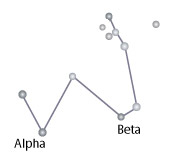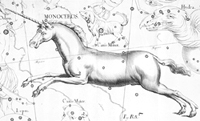Location: Galactic equator, visible in both hemispheres
Coordinates:
Right Ascension: 07h
Declination: -05º
Source: Modern
The story behind the name: Monoceros is a modern constellation formulated around 1624 by Jakob Bartsch, a German scientist. It is composed of a number of faint stars in an area between the well-known ancient constellations Canis Major and Minor, Orion, Gemini and Hydra. Monoceros, a Latinized version of the Greek word for "one-horned", is translated as "unicorn". One possible reference is to the unicorn of medieval and renaissance legend which is
usually portrayed as a white, horse-like creature with a single spiraled horn on its forehead. However the name "monoceros" can also refer to a far older mythological beast, a one-horned creature - part lion, part stag, and part horse - that was depicted in Assyrian art around the third millenium B.C.E. and which might have originated as a distorted or embellished interpretation of a rhinoceros.
Introduction to Constellations | Constellation Sources | Constellations Index
Objects observed by Chandra in Monoceros:



